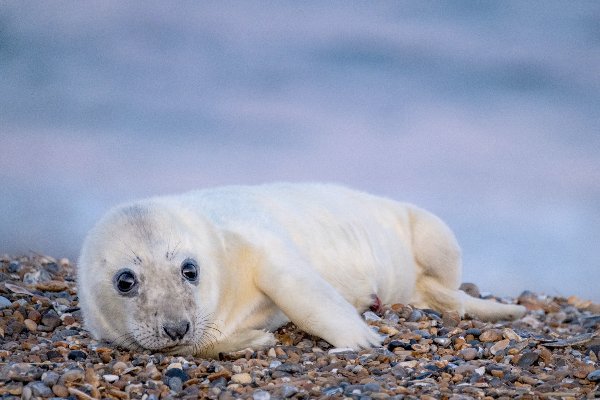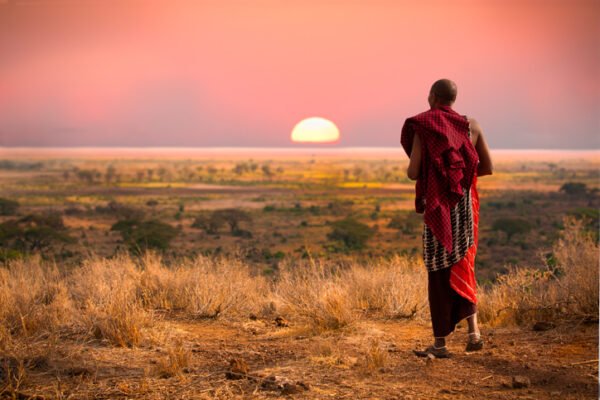Main image: Grey seal pup on the shore at Blakeney Point. Credit Hanne Siebers
Landscapes and wildlife across the UK are increasingly suffering the impacts of extreme weather events and natural disasters, says the National Trust.
While the year’s weather was uneventful at times, a handful of events and some unseasonal conditions caused devastation to important landscapes and coastline, and resulted in various ‘winners’ and ‘losers’ for our wildlife.
The impact of wildfires
With warmer, wetter winters, diseases such as ash dieback are taking hold and causing significant loss of trees, impacting landscapes and homes for nature.
The dry March and even drier April saw wildfires at two significant landscapes cared for by the conservation charity – the Mourne Mountains in Northern Ireland and Marsden Moor in Yorkshire, devastating 200 hectares and 520 hectares (two square miles) of moorland respectively.
Both areas lost a diverse range of plants and declining bird species were affected, such as skylark, meadow pipit, snipe (Mourne Mountains), curlew, golden plover and short-eared owl (Marsden Moor).
Other affected wildlife include Irish hare (Mourne Mountains) and mountain hare (Marsden), and important peat soils have been left scorched and destroyed.
Storms and coastal erosion
On the Dorset coast, a substantial 300m cliff fall in April – the largest for 60 years on this stretch of coastline – was caused by prolonged periods of dry weather, rain and erosion by the sea over several years, undermining the stability of the cliff and changing the shape of the coastline forever. This served as a reminder of the dynamic nature of our coastal habitats.
The late autumn was brought to an abrupt end last month as Storm Arwen ripped through the north of the country, causing widespread devastation, toppling hundreds of irreplaceable trees and plants at Bodnant garden in Wales and thousands in the Lake District.
At Wallington in Northumberland, where winds reached 98mph, over half of the 250-year-old oak and beech trees were also uprooted.
A ‘new normal’
A high of 32.2 degrees Celsius was recorded at Heathrow airport in July and a low of -23 degrees Celsius was recorded in Braemer in Aberdeenshire in February. This summer is expected to be within the top 10 warmest on record, evidence of the long-term trend of rising temperatures.
‘Climate change is making some forms of extreme weather events the new normal. Heatwaves and heavy rainfall are becoming more frequent and more intense. What we’re seeing in the UK with the impacts of wildfires and severe storms such as Arwen and Barra, is how climate change is altering our landscapes forever.
‘These dramatic incidents reflect what is going on elsewhere in the world, with extreme temperatures of over 50 degrees Celsius in California resulting in the state’s largest wildfire burning 390,000 hectares of land and extreme rainfall in China of 201.9mm in an hour resulting in devastating flash floods.
‘These extreme events are putting even more pressure on Britain’s wildlife, which is already in trouble with more than half of species in decline and 15 per cent of wildlife species under threat of extinction. Our nature is part of what makes the UK unique and we must all play our part to protect it.
‘The scale of the challenge we face is huge, but there is much we can do to heal climate harm. Isolated or small populations are the most at risk from climate impacts. Our conservation work protects and restores wildlife in our precious landscapes to help nature literally weather the storms. By conserving nature and improving habitats we can support larger populations that are better able to respond to the drivers of change and help nature’s survival.’
BEN MCCARTHY
Head of Nature Conservation and Restoration Ecology at the National Trust
Wildlife winners and losers in 2021
Wildflowers
Carpets of pyramidal orchids were seen across Rodborough Common in Gloucestershire in June and on the Golden Cap estate in Dorset bee orchids flowered profusely largely due to the very dry April and exceptionally warm June. The cold, wet May favoured the orchids which grow from tubers, with some growing to over 300mm tall.
Autumn Lady’s-tresses, the latest orchids to flower, had an exceptional year. Its spires of white flowers appeared in the thousands at some grasslands and sand dunes in southern England and Wales.
Butterflies
In contrast, this year saw the lowest number of butterflies recorded in the Butterfly Conservation’s Big Butterfly Count, with 60% of species in lower numbers than in 2020.
On National Trust land this year, teams noticed butterflies emerging later due to the very cool spring with numbers lower than normal at Blakeney, Holnicote and the New Forest – although the range of species still seemed good.
This was in stark contrast to 2020 when the early and warm spring resulted in early emergence, although 2020 ended up being an average year for many species due to the dull and wet summer.
Numbers of the endangered Large blue were down at both sites cared for by the Trust in Somerset and Gloucestershire, where the species was introduced in 2019 as part of the Large blue project.
Last year the population at Rodbourgh Common near Stroud was affected by drought while this year numbers were impacted by the cool and chilly spring with butterflies not emerging until June.
However, with new sightings across the common, the butterfly does appear to be extending its range which is an encouraging sign because more local populations across the area will reduce the risk of them becoming locally extinct and that the habitat restoration work is having positive results.
Another highlight included the first sighting of the mysterious Purple Emperor at Anglesey Abbey and further sightings at Sheringham Park, where it seems to have established itself since 2017.
Birds
The chilly April and May rain and gales led to a very poor nesting season for many species of bird at some places in the National Trust‘s care.
At Mount Stewart in Northern Ireland, a pair of barn owls abandoned their breeding site and the lapwings at Blakeney Freshes were put off by the cold ground conditions.
It was another topsy turvy year for terns at National Trust sites, with different species of these characterful and elegant seabirds either doing well or badly depending on their location and particular circumstances.
For example, Arctic tern numbers rebounded at Long Nanny in Northumberland thanks in part to restarting the 24-hour ranger surveillance of the nest sites post lockdown to help ward off predators, after two years of the birds struggling firstly with disease in 2019 and then with nests flooded out by storms and high tides in 2020.
38 individual Little Terns arrived in May, but the high tides at the end of the month flooded the area they use for nesting on the spit causing them to abandon the site.
At Blakeney Point in Norfolk the Sandwich and Common terns did well thanks to plentiful food and a lack of disturbance from people and dogs reflecting the role we can all play in nature’s recovery.
In contrast, despite a good start to the season and a peak little tern nest count, adult birds abandoned their nests scared off by the presence of a short-eared owl and a roost of common gulls.
At Cemlyn Nature Reserve on Anglesey, Sandwich terns and both common and Arctic terns had a good season, with the second highest nest count since 1982.
Common and Arctic terns also did well at Strangford Lough in Northern Ireland. However, in contrast there is increasing concern for the future of the Lough’s Sandwich terns which were down 14 per cent on last year.
‘Terns are some of the UK’s seabirds which literally live on the edge – not just in terms of their coastal habitats being squeezed by rising sea levels, but also at particular risk from human disturbance, predators and storm events at crunch times during the breeding season.
‘We suspect the reason for the recent declines of certain species is down to cold weather and more frequent heavy rain falling in the summer at the vital incubation and early post-hatch stage. Predation could also be a factor. This trend could continue if we get more frequent heavy rain in the summer as a result of climate change.
‘Another significant factor affecting the Sandwich tern numbers at Strangford Lough is that the reduced Black-headed Gull population meaning there are fewer opportunities for the two to nest alongside one another. The feisty gulls help fend off predators, but they also steal food that the terns bring back for their chicks. So despite it being a difficult relationship for the terns, overall they seem to do better when there are Black-headed Gulls around.’
BEN MCCARTHY
Head of Nature Conservation and Restoration Ecology at the National Trust
 Play Video about This Rock Might Just Save The World
Play Video about This Rock Might Just Save The World Play Video about Play 2 hours of rock
Play Video about Play 2 hours of rock Play Video about Play 2 hours of brook
Play Video about Play 2 hours of brook Play Video about Play 2 hours of sheep
Play Video about Play 2 hours of sheep











































